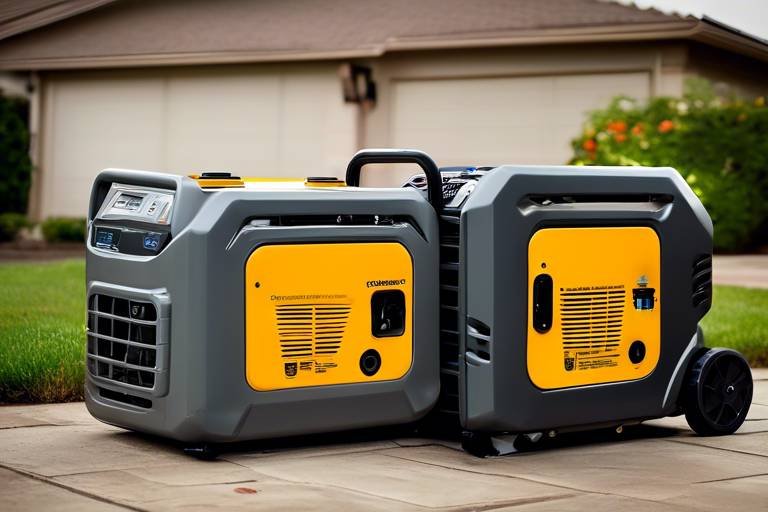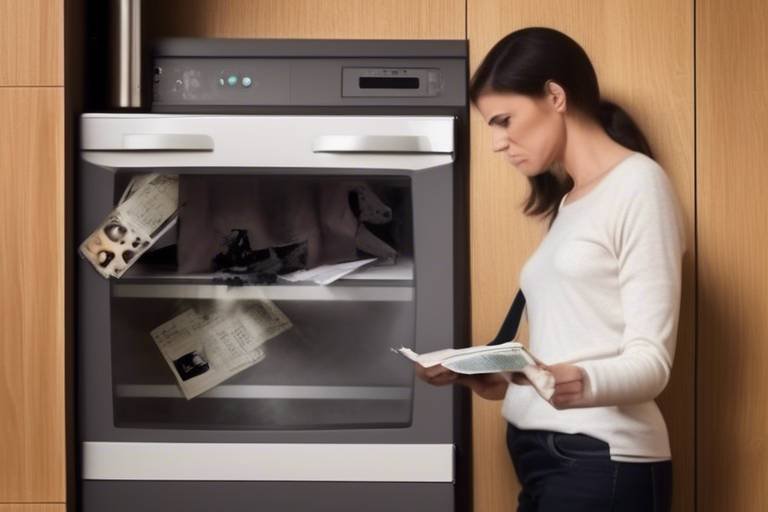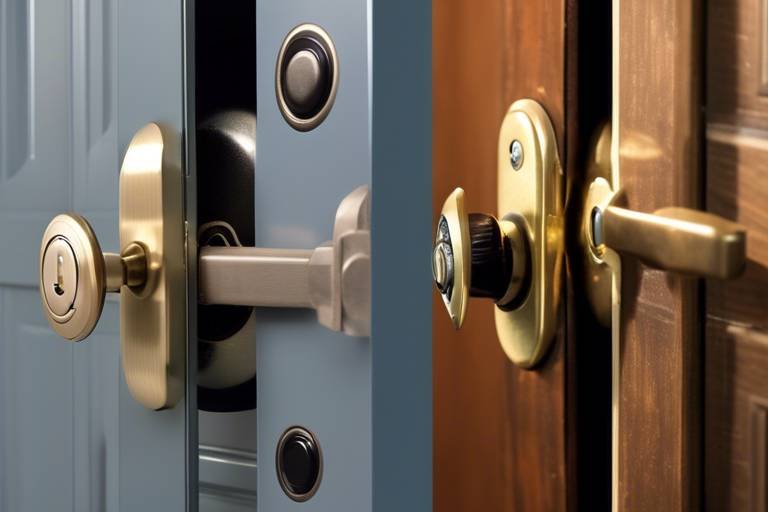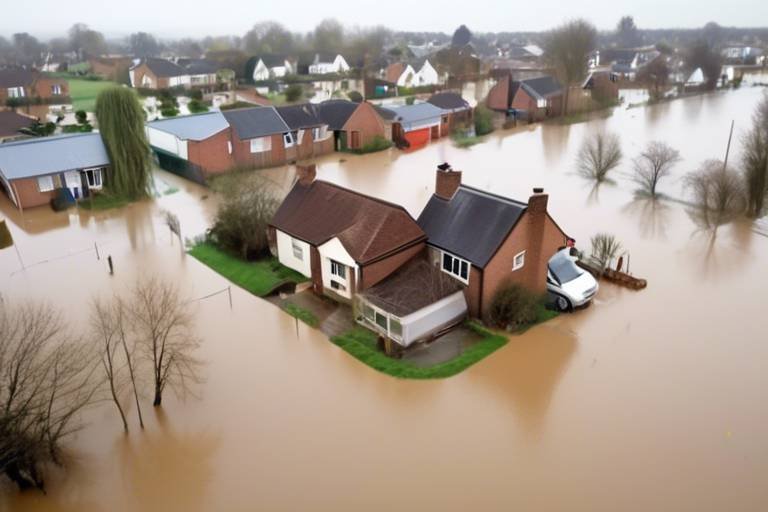How to Ensure Safety Using Generators at Home
In today's world, generators have become essential for ensuring a steady power supply during outages, especially in areas prone to extreme weather. However, while they can be incredibly useful, it’s crucial to prioritize safety when using them at home. This article explores essential safety measures and best practices for using generators at home, ensuring both efficiency and protection from potential hazards associated with generator use. By understanding the risks and implementing proper safety protocols, you can enjoy the benefits of your generator without compromising your family's safety.
Different types of generators serve various purposes. Understanding the distinctions between portable, standby, and inverter generators can help you choose the right one for your home and safety needs. Portable generators are versatile and can be moved easily, making them ideal for outdoor activities or temporary power needs. Standby generators, on the other hand, are permanently installed and automatically kick in during power outages, providing a seamless power supply. Lastly, inverter generators are known for their quiet operation and clean energy output, making them perfect for sensitive electronics. By knowing what type of generator suits your needs, you can ensure safer operation and avoid common pitfalls.
The placement of your generator is crucial for safety. Learn the best practices for positioning your generator to avoid carbon monoxide buildup and ensure efficient operation. Ideally, generators should be placed outdoors, away from doors, windows, and vents. This minimizes the risk of harmful fumes entering your home. Additionally, consider the surface on which you place your generator; a flat, stable surface will help prevent tipping and allow for proper ventilation. Remember, placing your generator in a well-ventilated area is not just a good practice—it's a lifesaver.
Adequate ventilation is essential when using generators. Discover how to create a safe environment that minimizes the risk of carbon monoxide poisoning while maximizing generator performance. Always ensure that the area around the generator is free from obstructions that could block airflow. For example, if you have a portable generator, position it at least 20 feet away from your home and in an open space. This distance helps disperse any exhaust fumes quickly, reducing the risk of inhalation. It's like having a safety bubble—keeping harmful gases at bay while you enjoy the conveniences of electricity.
Keeping generators at a safe distance from living spaces is vital. This section discusses recommended distances to prevent harmful gas exposure and ensure safety for all household members. As a rule of thumb, always maintain a distance of at least 15 to 20 feet from your home. This distance not only protects you from carbon monoxide but also allows for safe operation without the noise disrupting your daily life. Think of it as giving your generator its own personal space to work its magic without endangering your family.
Protecting your generator from the elements is important for safety and longevity. Learn how to shield your generator from rain, snow, and extreme temperatures without compromising ventilation. A simple solution is to use a generator cover that is specifically designed for outdoor use. These covers will protect your generator from moisture while allowing for proper airflow. Additionally, consider building a small shelter or canopy that can provide protection from the elements without enclosing the generator entirely. This balance between protection and ventilation is key to keeping your generator in top shape.
Electrical safety is paramount when operating a generator. This section highlights key precautions to take when connecting your generator to home electrical systems to prevent overload and hazards. Always use a transfer switch to connect your generator to your home’s electrical system. This device ensures that power flows in one direction—keeping utility workers safe while they restore power. Avoid plugging your generator directly into a wall outlet, as this can create a dangerous backfeed of electricity. Just imagine the chaos it could cause—like opening a floodgate when you only wanted a gentle stream!
Regular maintenance and inspection of your generator can prevent accidents and ensure optimal performance. Explore essential maintenance tasks that every generator owner should perform regularly. Make it a habit to check the oil level, clean or replace air filters, and inspect fuel lines for leaks. Keeping a maintenance log can help you track what has been done and when. Think of your generator as a car; regular check-ups will keep it running smoothly and safely, avoiding unexpected breakdowns when you need it the most.
Handling fuel safely is crucial for generator operation. This section outlines best practices for storing and using fuel to prevent spills, fires, and other hazards. Always store fuel in approved containers and keep them in a cool, dry place away from direct sunlight. Additionally, never refuel your generator while it’s running—this can lead to spills and fires. Instead, turn the generator off, let it cool down, and then refuel. It’s a simple step that can save you from a potentially dangerous situation.
Recognizing signs of potential generator problems can prevent accidents. Learn the common indicators that suggest your generator may need repairs or maintenance to ensure safe operation. If you notice unusual noises, vibrations, or if the generator fails to start, it’s time to investigate. Ignoring these signs can lead to more significant issues down the line, much like ignoring a small leak in your roof that could turn into a major repair job. So, keep an eye (and ear) out for any red flags!
Being prepared for emergencies is vital when using generators. This section discusses how to create an emergency plan that includes generator use, ensuring your family stays safe during power outages. Start by outlining how and when to use the generator, and ensure everyone in your household knows the plan. Practice using the generator so that everyone feels comfortable operating it during an actual emergency. Remember, preparation is your best ally when the lights go out!
- What is the safest distance to keep my generator from my home? It's recommended to keep your generator at least 15 to 20 feet away from any living spaces.
- Can I use my generator indoors? No, generators should never be used indoors due to the risk of carbon monoxide poisoning.
- How often should I perform maintenance on my generator? Regular maintenance should be performed at least once a year, or more frequently if used often.
- What type of fuel should I use for my generator? Always use the fuel type specified in your generator's manual, typically gasoline or propane.

Understanding Generator Types
When it comes to choosing a generator for your home, understanding the different types available is crucial. Each type of generator serves a unique purpose and comes with its own set of advantages and disadvantages. It's like picking the right tool for a job; using the wrong one can lead to inefficiency and even safety hazards! So, let's break down the three main types of generators: portable, standby, and inverter.
Portable generators are the most common type you’ll encounter. They are versatile and can be moved easily, making them perfect for outdoor activities like camping or tailgating, as well as for home use during power outages. However, while they’re convenient, they require manual setup and can only power a limited number of appliances at a time. So, if you’re planning to run your refrigerator, lights, and maybe a few other devices, you’ll need to be mindful of the generator's wattage capacity.
On the other hand, standby generators are permanently installed and automatically kick in when the power goes out. Imagine not having to worry about setting up your generator in the middle of a storm! These generators are usually powered by natural gas or propane and can power your entire home, depending on the model. However, they are more expensive and require professional installation, which is something to consider if you're on a budget.
Lastly, we have inverter generators, which are a bit of a hybrid. They produce cleaner energy, making them ideal for sensitive electronics like laptops and smartphones. Inverter generators are typically quieter and more fuel-efficient than traditional portable generators. However, they may not have the same power output, so if you need to run heavy-duty appliances, you’ll want to check the specifications carefully.
In summary, when selecting a generator, consider the following:
- Power Needs: What appliances do you need to power?
- Portability: Will you be moving it around, or is it for stationary use?
- Fuel Type: Are you okay with gasoline, or would you prefer natural gas or propane?
- Budget: How much are you willing to invest in a generator?
Understanding these types is the first step towards ensuring safety and efficiency in your generator use at home. Choosing the right generator not only meets your power needs but also contributes to a safer environment for you and your family.

Proper Placement of Generators
When it comes to using generators at home, the placement is not just a matter of convenience; it’s a crucial aspect of safety. Imagine setting up a tent in a storm—you wouldn’t want it too close to a tree that could fall, right? Similarly, the location of your generator can significantly impact your safety and the efficiency of its operation. Positioning your generator correctly can prevent dangerous situations, such as carbon monoxide poisoning, which can occur if the exhaust fumes are allowed to accumulate in enclosed spaces.
So, where should you place your generator? First and foremost, it should be located outside, away from doors, windows, and vents. The general rule of thumb is to keep it at least 20 feet away from your home. This distance helps ensure that the dangerous gases emitted by the generator have enough space to dissipate into the air rather than seeping into your living areas. Think of it like keeping a campfire at a safe distance from your tent—no one wants to wake up to smoke filling the air!
Moreover, it’s essential to consider the ventilation requirements of your generator. Adequate airflow is vital for its operation and your safety. If your generator is placed in a confined space, it can lead to an accumulation of harmful gases. To create a safe environment, ensure that the area around the generator is clear of obstructions. This includes avoiding placing it near flammable materials like wood piles, fuel containers, or dry leaves. A clear space allows for better air circulation, reducing the risk of overheating and ensuring the generator runs efficiently.
Creating a safe environment around your generator involves understanding its ventilation needs. Generators need fresh air to operate effectively and to disperse exhaust fumes. You can enhance ventilation by ensuring that the area is well-aerated. If possible, position the generator in an open area where air can flow freely. Avoid placing it in garages, basements, or any enclosed structure—even if the doors or windows are open. Just like you wouldn’t want to breathe in smoke from a barbecue in a closed room, your generator needs an open space to function safely.
As mentioned earlier, maintaining a safe distance from living spaces is crucial. The recommended distance of 20 feet serves as a guideline, but it’s always better to err on the side of caution. If your generator is particularly loud, consider placing it even further away to minimize noise disturbance. Additionally, ensure that the exhaust is directed away from your home to avoid any buildup of harmful gases.
Weather can be unpredictable, and protecting your generator from the elements is vital for both its longevity and safe operation. While you want it to be outside for proper ventilation, you also need to shield it from rain, snow, and extreme temperatures. A simple solution is to use a generator cover that allows for airflow while protecting it from the elements. Just remember, never cover the generator while it's running, as this can lead to overheating.
In summary, the proper placement of your generator involves a few key considerations: distance from your home, adequate ventilation, and protection from the weather. By following these guidelines, you can ensure that your generator operates efficiently while keeping your home and family safe from potential hazards.
Q: Can I use my generator indoors?
A: No, you should never use a generator indoors or in any enclosed spaces due to the risk of carbon monoxide poisoning.
Q: How far should my generator be from my house?
A: It is recommended to keep your generator at least 20 feet away from your home to ensure safety.
Q: What should I do if it rains while I'm using the generator?
A: If it rains, ensure your generator is covered with a weather-resistant cover that allows for ventilation. Never cover it while it's running.

Ventilation Requirements
When it comes to using generators, adequate ventilation is not just a good idea; it’s a **necessity**. Generators produce exhaust gases, including carbon monoxide, which is a colorless, odorless gas that can be deadly in high concentrations. Imagine having a cozy night at home during a power outage, only to find out that your generator's placement has turned your sanctuary into a potential hazard. To prevent this from happening, you need to ensure that your generator operates in a well-ventilated area.
First and foremost, always position your generator outdoors, away from windows, doors, and vents. This simple step can significantly reduce the risk of carbon monoxide entering your home. The recommended distance is at least 20 feet from any structure. Think of it like a campfire—if you sit too close, the smoke will find its way to you, and the same goes for generator exhaust. The further away it is, the better.
Additionally, consider the wind direction when setting up your generator. If the wind is blowing towards your home, you might want to adjust the placement to avoid any harmful gases drifting towards your living area. It’s all about keeping the air clean and safe for your family. You wouldn’t want to breathe in the fumes, would you?
Moreover, it's essential to avoid placing your generator in enclosed spaces like garages, basements, or sheds, even if the doors are open. These areas can trap exhaust fumes, leading to a dangerous buildup of carbon monoxide. Instead, opt for a location that allows for free airflow. If you have to use a generator in a semi-enclosed area, consider using exhaust fans to help disperse the fumes, but remember that this is not a foolproof solution.
Another critical aspect of ventilation is ensuring that your generator is on a stable and level surface. This not only helps with the generator's performance but also prevents any accidental tipping that could lead to fuel spills. A spill combined with poor ventilation can create a recipe for disaster. So, always check your surroundings before firing up the generator.
In summary, proper ventilation is crucial for safe generator use. Here are the key points to remember:
- Always place your generator outdoors, at least 20 feet away from your home.
- Consider wind direction to avoid exhaust fumes blowing into your living space.
- Avoid enclosed spaces to prevent carbon monoxide buildup.
- Ensure a stable and level surface for your generator.
By following these ventilation requirements, you can enjoy the benefits of your generator without compromising your safety. Remember, a little caution goes a long way in keeping your home and loved ones safe!

Distance from Living Areas
When it comes to using generators at home, one of the most critical safety measures is ensuring that your generator is placed at a safe distance from living areas. Why is this so important? Well, generators emit carbon monoxide, a colorless and odorless gas that can be extremely dangerous, even lethal, if inhaled in sufficient quantities. To protect your family and pets, it’s essential to follow the recommended distances established by safety organizations.
The general guideline is to keep your generator at least 20 feet away from any doors, windows, or vents. This distance helps to ensure that harmful exhaust fumes do not seep into your home. However, the specific distance may vary based on local regulations, so it’s wise to check with your local authorities or the manufacturer’s guidelines for the best practices.
In addition to the distance from your home, consider the layout of your yard. Are there any obstacles that could trap fumes? For example, placing your generator near fences, walls, or large bushes can create a pocket of dangerous gas that could linger around your home. It’s best to choose an open area that allows for proper ventilation. Think of it like setting up a bonfire; you wouldn’t want to sit too close to the flames, right? The same principle applies here.
Moreover, if you live in an area with high winds, you might want to adjust your generator's placement even further. Wind can carry carbon monoxide in unexpected directions, so positioning your generator away from your home and in a well-ventilated area can be the difference between a safe experience and a hazardous one.
To summarize, here are key points to remember:
- Keep the generator at least 20 feet away from your home.
- Ensure there are no obstacles that could trap exhaust fumes.
- Consider wind direction when placing your generator.
By following these guidelines, you not only enhance your safety but also ensure that your generator operates efficiently without any unnecessary risks. Remember, safety should always come first when dealing with potentially hazardous equipment like generators.
Q1: How far should I place my generator from my home?
A1: It's recommended to keep your generator at least 20 feet away from doors, windows, and vents to prevent carbon monoxide buildup inside your home.
Q2: Can I use my generator in a garage?
A2: No, you should never use a generator inside a garage or any enclosed space, as this can lead to dangerous carbon monoxide accumulation.
Q3: What should I do if I notice signs of carbon monoxide poisoning?
A3: If you suspect carbon monoxide poisoning, immediately move to fresh air and seek medical attention. Symptoms include headache, dizziness, and confusion.
Q4: Is it safe to use a generator during a storm?
A4: While it can be safe to use a generator during a storm, ensure it is placed away from flood-prone areas and always follow safety guidelines for distance and ventilation.

Weather Protection
When it comes to using generators, one of the often-overlooked aspects is . Just like you wouldn't leave your car out in a hailstorm, your generator also deserves some TLC when it comes to shielding it from the elements. Extreme weather conditions like rain, snow, and intense heat can not only hinder the performance of your generator but can also lead to serious safety hazards. So, how do you ensure that your generator remains in tip-top shape, regardless of what Mother Nature throws at you?
First off, consider investing in a generator cover. These covers are designed specifically to protect your generator from rain and snow while still allowing it to breathe. It's essential to choose a cover that fits snugly over your generator, as a loose cover can trap moisture and lead to rust or other damage. Additionally, look for materials that are both waterproof and breathable to prevent condensation buildup.
Next, think about the placement of your generator. If possible, position it under a permanent shelter such as a gazebo or a shed. However, it's crucial to ensure that the shelter allows for adequate ventilation. You wouldn’t want to create a cozy little spot for your generator that ends up being a carbon monoxide trap! Keeping the generator elevated on a platform can also help keep it dry during heavy rain or snow. Just make sure that the platform is stable and can support the weight of the generator.
Furthermore, it’s wise to regularly check the generator for any signs of weather-related wear and tear. Look for rust, cracks, or any other damage that could compromise its functionality. If you notice any issues, address them immediately to prevent further problems down the line. Remember, a little maintenance can go a long way in ensuring your generator's longevity.
Lastly, consider the use of a weather-resistant enclosure if you live in an area prone to severe weather. These enclosures can protect your generator from heavy winds, snow accumulation, and even falling branches. Just ensure that these enclosures are designed with proper ventilation to avoid overheating and carbon monoxide buildup.
In summary, protecting your generator from the weather is not just about prolonging its life; it's about ensuring your safety and the safety of your loved ones. By taking the necessary precautions, you can rest easy knowing that your generator is ready to perform when you need it most, no matter the weather!
- How often should I check my generator for weather damage? It’s a good idea to inspect your generator every few months, especially before and after extreme weather events.
- Can I use a tarp to cover my generator? While a tarp can provide temporary protection, it’s best to use a cover specifically designed for generators to ensure proper ventilation.
- What should I do if my generator gets wet? If your generator gets wet, ensure it is completely dry before attempting to start it. Check for any electrical damage before use.

Electrical Safety Tips
When it comes to using generators, electrical safety is not just a guideline; it’s a necessity. Generators can provide essential power during outages, but improper use can lead to dangerous situations, including electrical shocks and fires. So, how can you ensure that your generator use is safe? First and foremost, always refer to the manufacturer's manual for specific instructions and safety guidelines tailored to your particular model.
One of the most critical aspects of electrical safety is understanding how to properly connect your generator to your home’s electrical system. If you're planning to use your generator for home power, it's essential to have a transfer switch installed by a licensed electrician. This device prevents back-feeding electricity into the grid, which can pose a serious risk to utility workers and your own electrical system. Without a transfer switch, there’s a high risk of overloading circuits, which can lead to fires or equipment damage.
Additionally, always make sure to use heavy-duty, outdoor-rated extension cords to connect appliances to your generator. These cords are designed to handle the load and reduce the risk of overheating. When connecting devices, be mindful of their total wattage; exceeding your generator’s capacity can lead to overheating and equipment failure. To help visualize this, consider the following table:
| Appliance | Starting Watts | Running Watts |
|---|---|---|
| Refrigerator | 1,200 | 800 |
| Air Conditioner | 3,000 | 1,500 |
| Microwave | 1,200 | 1,000 |
| Space Heater | 1,500 | 1,500 |
As you can see, understanding the wattage requirements of your appliances is crucial. Always calculate the total wattage of devices you plan to run simultaneously to ensure your generator can handle the load. If you’re unsure, consult with an electrician who can provide guidance based on your specific needs.
Another important tip is to never operate a generator indoors or in enclosed spaces, even if windows are open. Carbon monoxide is a silent killer, and generators produce this deadly gas as a byproduct of combustion. Always place your generator at least 20 feet away from your home and any other structures to minimize the risk of gas buildup. Remember, safety first!
Lastly, keep a close eye on your generator during operation. Regularly check for any signs of damage or wear, such as frayed cords or leaks. If you notice anything unusual, turn off the generator and have it inspected before using it again. Your diligence can prevent accidents and keep your home safe while you enjoy the benefits of your generator.
- Can I use a generator in my garage? No, you should never use a generator in an enclosed space like a garage due to the risk of carbon monoxide poisoning.
- How often should I perform maintenance on my generator? Regular maintenance should be performed at least once a year, or more frequently if you use it often.
- What should I do if my generator starts making strange noises? Turn it off immediately and check for any visible issues. If unsure, consult a technician.

Maintenance and Inspection
When it comes to ensuring the longevity and safety of your generator, regular maintenance and inspection are not just recommended; they are essential. Think of your generator as a car: it requires routine check-ups to keep it running smoothly and safely. Neglecting maintenance can lead to unexpected breakdowns, which can be not only inconvenient but also dangerous. So, what should you be looking for during these inspections?
First and foremost, you should check the oil level regularly. Just like your vehicle, a generator needs oil to function properly. Low oil levels can lead to engine damage, so make it a habit to inspect and change the oil as needed. Additionally, you should look at the air filter. A dirty air filter can restrict airflow, causing your generator to work harder than necessary, which can lead to overheating. If you notice that your air filter is clogged, it’s time for a replacement.
Another critical aspect of maintenance is the fuel system. Inspect the fuel lines for any signs of wear or leaks. If you find any issues, it’s better to address them sooner rather than later to avoid any fire hazards. Furthermore, storing fuel properly is crucial. Always use fuel stabilizers if you plan on storing your generator for an extended period. This helps prevent the fuel from going stale, which can cause starting issues later.
Don’t forget about the battery! Just like in your car, the battery in your generator needs to be checked. Make sure the terminals are clean and free from corrosion, and test the battery regularly. A dead battery can leave you stranded during an emergency, and nobody wants that kind of surprise.
Here’s a quick reference table summarizing the key maintenance tasks:
| Maintenance Task | Frequency | Notes |
|---|---|---|
| Check Oil Level | Every 50 hours | Change oil if low |
| Inspect Air Filter | Every 100 hours | Replace if dirty |
| Examine Fuel Lines | Every 100 hours | Look for leaks or wear |
| Test Battery | Monthly | Clean terminals as needed |
In addition to these tasks, it's wise to perform a full inspection of your generator at least once a year. This includes checking the spark plugs, which can become fouled over time and affect performance. Replacing spark plugs is a simple task that can significantly improve your generator's efficiency. Also, consider running your generator monthly for at least 30 minutes, even if you don’t need it. This practice keeps the engine lubricated and helps identify any issues before they become major problems.
Lastly, keep a detailed maintenance log. Documenting what you’ve done and when can help you stay on top of your generator's needs and can be invaluable should you ever need to refer back to past maintenance or repairs. It’s like keeping a diary for your generator—who knew they could be so high-maintenance?
Q: How often should I perform maintenance on my generator?
A: It's recommended to perform basic maintenance every 50 to 100 hours of use, with a full inspection at least once a year.
Q: What should I do if my generator won’t start?
A: Check the fuel level, battery condition, and oil level. If everything seems fine and it still won’t start, it may need professional servicing.
Q: Can I use my generator in the rain?
A: It’s best to keep your generator dry to prevent electrical hazards. Use a cover designed for generators, but ensure it has adequate ventilation.

Fuel Safety Practices
When it comes to using generators, fuel safety is non-negotiable. Proper handling and storage of fuel can make the difference between a smooth operation and a potentially dangerous situation. First and foremost, always store fuel in approved containers that are specifically designed for the type of fuel you are using. These containers are engineered to minimize the risk of leaks and spills, which can lead to hazardous situations. You wouldn't want to mix fuels or use makeshift containers, would you? It’s like trying to drive a car with the wrong fuel—it's just not going to work out well!
Additionally, always keep your fuel in a cool, dry place away from direct sunlight and heat sources. High temperatures can increase the risk of combustion, so think of your fuel storage as a mini fortress—it needs to be protected from the elements. Make sure to check your fuel regularly for any signs of contamination or degradation. If it smells off or has a strange color, it’s better to be safe than sorry—dispose of it properly.
When you’re ready to refuel your generator, make sure it’s turned off and has cooled down. Refueling a hot generator can lead to fires or explosions, and nobody wants that! Always use a funnel to prevent spills, and never overfill the tank. Leave some space for fuel expansion; think of it as giving your fuel room to breathe. If you do spill any fuel, clean it up immediately and dispose of it according to local regulations. A small spill can turn into a big problem if left unattended.
Another important aspect of fuel safety is ventilation. Ensure that you’re in a well-ventilated area when handling fuel to avoid inhaling harmful fumes. If you're refueling indoors, you might as well be inviting trouble in for tea! And let’s not forget about the importance of having a fire extinguisher nearby. It’s a small price to pay for peace of mind.
To summarize, here are a few key fuel safety practices to keep in mind:
- Store fuel in approved containers.
- Keep fuel in a cool, dry place.
- Refuel only when the generator is turned off and cool.
- Use a funnel to avoid spills.
- Maintain good ventilation when handling fuel.
- Have a fire extinguisher on hand.
By following these fuel safety practices, you’ll not only ensure the efficient operation of your generator but also protect your home and loved ones from potential hazards. Remember, safety first!
Q: What type of fuel should I use for my generator?
A: Always refer to your generator's manual for the recommended fuel type. Most portable generators use gasoline, while standby generators may use natural gas or propane.
Q: How often should I check my fuel?
A: It's a good practice to check your fuel levels and quality regularly, especially before and after usage. This ensures that you always have fresh fuel on hand.
Q: Can I store fuel in my garage?
A: Yes, but it should be in a cool, dry area away from heat sources and direct sunlight. Make sure it's stored in approved containers and away from living spaces.
Q: What should I do if I spill fuel?
A: Clean up the spill immediately using appropriate materials. Follow local regulations for disposal and ensure the area is ventilated to avoid inhaling fumes.

Signs of Generator Issues
Generators are incredibly useful devices, especially during power outages, but they can also present hazards if they are not functioning correctly. Recognizing the signs of generator issues early can save you from potentially dangerous situations and costly repairs. So, how do you know if your generator is trying to tell you something? Here are some common indicators that your generator may need attention.
First and foremost, unusual noises can be a significant red flag. If your generator starts making sounds that are outside its normal operating range—think loud clanking, grinding, or high-pitched whines—this could indicate mechanical problems. Just like a car, generators can develop issues that require immediate attention. Ignoring these sounds could lead to further damage or even complete failure.
Another sign to watch for is inconsistent power output. If you notice that the lights flicker or appliances don’t run smoothly when connected to the generator, it could be a sign of an underlying electrical issue. This inconsistency can lead to damage to your devices and even pose safety risks. Make a habit of observing the performance of your generator, especially during heavy loads.
Additionally, keep an eye out for leaks. Fuel or oil leaks are not just messy; they can create serious fire hazards. If you see any puddles or stains around your generator, it’s time to investigate further. Fuel leaks can also affect the efficiency of your generator, leading to poor performance when you need it most.
Moreover, excessive exhaust fumes can indicate issues with your generator. While some exhaust is expected, a sudden increase in smoke or a change in color—especially a blue or black tint—can signal that something is wrong. This could be due to improper fuel combustion or other internal problems that require immediate attention.
Lastly, don’t overlook the control panel. If warning lights are illuminated or if the panel displays error codes, it’s a clear indication that your generator is trying to communicate with you. Consult the owner’s manual to decode these signals and take the necessary steps to rectify the situation.
To summarize, here are some key signs that your generator may be experiencing issues:
- Unusual noises during operation
- Inconsistent power output
- Fuel or oil leaks
- Excessive or discolored exhaust fumes
- Warning lights or error codes on the control panel
By staying vigilant and addressing these signs promptly, you can ensure that your generator remains safe and reliable. Regular maintenance and inspections are essential, but being aware of the warning signs is equally important. After all, your generator is there to provide you with peace of mind during power outages, so don’t let minor issues turn into major problems!
Q: How often should I inspect my generator for issues?
A: It's recommended to inspect your generator at least once a month and perform more thorough maintenance every six months, especially if you use it frequently.
Q: What should I do if I notice a problem with my generator?
A: If you observe any signs of issues, turn off the generator immediately and consult a professional technician for a thorough inspection and repair.
Q: Can I use my generator indoors?
A: No, generators should never be used indoors due to the risk of carbon monoxide poisoning. Always operate them in well-ventilated outdoor areas.
Q: How can I improve the lifespan of my generator?
A: Regular maintenance, proper storage, and timely repairs can significantly enhance the lifespan of your generator. Always follow the manufacturer's guidelines for usage and care.

Emergency Preparedness
When it comes to using generators, being prepared for emergencies is not just a good idea; it’s essential. Imagine a storm rolling in, the lights flicker, and suddenly, you're plunged into darkness. Having a generator on hand can be a lifesaver, but do you have a plan for how to use it safely? Creating an emergency plan that includes generator use is crucial for ensuring your family stays safe during power outages. This plan should outline not only how to operate your generator but also how to do so in a way that minimizes risks.
First and foremost, you need to understand the importance of communication. Make sure every family member knows what to do when the power goes out. This includes knowing where the generator is stored, how to start it, and the safety precautions that need to be taken. Consider holding a family meeting to discuss these points; after all, practice makes perfect! You wouldn't want to be fumbling around in the dark when the lights go out, right?
Additionally, it's important to have a designated area where your generator will be set up. This area should be easy to access and away from living spaces to prevent harmful gas exposure. Ideally, you should keep the generator at least 20 feet away from windows, doors, and vents. This distance helps reduce the risk of carbon monoxide entering your home. It’s also wise to have a plan for securing your generator in case of theft, especially during widespread outages when many people may be relying on generators.
Moreover, consider creating a generator checklist that includes the following items:
- Fuel type and quantity
- Extension cords rated for outdoor use
- Safety goggles and gloves
- First aid kit
By having these essentials on hand, you can ensure that you're ready to roll when the power goes out. Don't forget to also check the weather forecast regularly. If a storm is brewing, it’s a good idea to test your generator ahead of time to ensure it’s in working order. You wouldn’t want to discover that it’s malfunctioning when you need it most!
Lastly, don’t underestimate the power of knowledge. Familiarize yourself with the manufacturer’s instructions for your specific generator model. This will give you insights into safe operation and maintenance practices. Consider keeping a printed copy of the manual in your emergency kit for quick reference. Remember, preparation is key to ensuring that your generator provides the support you need during an emergency.
| Question | Answer |
|---|---|
| What should I do if my generator isn't starting? | Check the fuel level, ensure the choke is in the correct position, and inspect the battery if applicable. |
| How can I prevent carbon monoxide poisoning? | Always place your generator outdoors, away from windows and doors, and use a carbon monoxide detector inside your home. |
| Can I run my generator in the rain? | No, never operate your generator in wet conditions unless it is specifically designed for such use. Use a canopy or tarp for protection. |
| How often should I perform maintenance on my generator? | Regular maintenance should be performed at least once a year, or more frequently if used often, including oil changes and air filter replacements. |
Frequently Asked Questions
- What types of generators are available for home use?
There are three main types of generators you can consider for home use: portable generators, which are versatile and can be moved easily; standby generators, which are permanently installed and automatically kick in during power outages; and inverter generators, known for their quiet operation and efficiency. Understanding these types will help you choose the right generator that meets your safety and power needs.
- How far should I place my generator from my home?
It's crucial to keep your generator at least 20 feet away from your home to prevent carbon monoxide buildup and ensure safety. This distance helps to keep harmful gases away from living areas, protecting your family from potential poisoning. Always check the manufacturer’s guidelines for specific recommendations based on your generator model.
- What are the ventilation requirements when using a generator?
Proper ventilation is essential to minimize the risk of carbon monoxide poisoning. Always operate your generator outdoors, in a well-ventilated area, and never in enclosed spaces like garages or basements. Ensure that exhaust fumes can disperse freely, and consider using a carbon monoxide detector to monitor levels in your home.
- How can I protect my generator from bad weather?
To shield your generator from rain, snow, and extreme temperatures, consider using a generator cover or building a simple shelter that allows for adequate ventilation. Avoid placing your generator in direct contact with the ground to prevent water damage, and ensure that any shelter you create does not obstruct airflow.
- What are some electrical safety tips for using a generator?
Always connect your generator to your home’s electrical system using a transfer switch to prevent backfeeding, which can be dangerous. Additionally, avoid overloading your generator by checking its wattage capacity and only powering essential appliances. It’s also wise to use heavy-duty extension cords rated for outdoor use.
- How do I maintain my generator?
Regular maintenance is key to keeping your generator in top shape. This includes checking the oil level, replacing air filters, and inspecting fuel lines for leaks. Make it a habit to run your generator periodically, even when not in use, to ensure it operates smoothly when needed.
- What fuel safety practices should I follow?
Store fuel in approved containers and keep it in a cool, dry place away from direct sunlight. Always handle fuel outdoors and avoid smoking or using open flames nearby. When refueling your generator, turn it off and let it cool down to prevent fires or explosions.
- What signs indicate my generator needs maintenance?
Look out for signs like strange noises, smoke, or difficulty starting. If your generator is not producing power or is running inconsistently, it may need attention. Regularly check for any leaks or unusual smells, as these can indicate serious issues that require immediate repair.
- How can I prepare for emergencies with my generator?
Creating an emergency plan is essential. Ensure that all family members know how to operate the generator safely and understand its location. Keep essential supplies, including fuel and extension cords, on hand. Regularly review and practice your emergency plan to ensure everyone is prepared when power outages occur.



















